


xxxxxAs to be expected, the
revolution in France in July 1830, which replaced the reactionary Charles X with the more
moderate Louis-Philippe, had repercussions across Europe. The
Belgians were the first to make a bid for independence. As we have
seen, in the Vienna settlement of 1815
(G3c) their country, the former Austrian
Netherlands, had been united with the Dutch United Provinces, ruled
by William I. It was a union doomed to failure. The two peoples had
a different language, culture and religion, and the Belgians
bitterly resented the fact that the official language was Dutch, and
that they were under-represented in the States General. The
rebellion broke out in Brussels in August 1830, and quickly spread
across the French-speaking south. War seemed inevitable, but
the great powers stepped in and imposed an armistice. Then in
January 1831 an
international conference in London came out in favour of Belgian
independence, due mainly to the diplomacy of the British foreign
secretary Lord Palmerston, and the French ambassador in London,
Charles Maurice Talleyrand. At first, William I opposed the
settlement and attempted to take back the southern region by force,
but in 1838 his parliament recognised Belgium and its borders, and
in the following year the great powers guaranteed the permanent
neutrality of the new state.
POPULAR UPRISINGS IN EUROPE 1831 (W4)
INCLUDING BELGIAN INDEPENDENCE
Acknowledgements
Map (Belgium):
licensed under Creative Commons –
kohlerhistory.wikispaces.com/Belgium. Talleyrand:
by the French painter Pierre-Paul Prud’hon (1758-1823),
1809 – Château de Valençay, France. Palmerston:
by the Scottish painter Frederick Cruikshank (1800-1868),
1855. Map (Poland): licensed under
Creative Commons. Author: Mariusz Pazdziora – en.wikipedia.org.
Map (German Confederation): source unknown.
xxxxxAs we have seen, the
violent revolution which broke out in France in July 1830 succeeded in toppling the reactionary king Charles X
and replacing him by the constitutional monarch Louis-Philippe.
Not surprisingly, it quickly sparked off popular risings in many
parts of “congress Europe”. But this was not a revolution like that
of 1789, far from it. The new French leader was not prepared to
launch his country upon a political crusade. He was intent on giving
France a much needed period of peace. Those Liberals who took up
arms against conservative regimes or foreign domination -
shored up by the Congress System - found themselves on their
own. They met with success or they went down fighting.
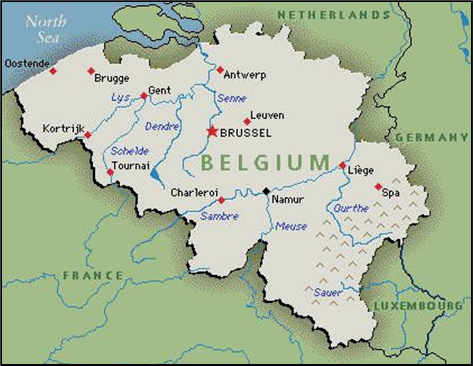 xxxxxThe first to seek independence was Belgium, the former
Austrian Netherlands. As we have seen, by the Congress of Vienna in
1815 (G3c), this
country, together with the United Provinces, was formed into the
Kingdom of the Netherlands and placed under the sovereignty of the
Dutch House of Orange. Established simply to provide a buffer state
against French expansion to the north, it was a union doomed to
failure. The two countries were separated by centuries of tradition,
spoke different languages, and were divided by religious faith and
racial make-up. From the beginning of the new state the
Belgians of the south saw themselves as second-class citizens
under the stern rule of their Dutch masters. Though they regarded
themselves as more eloquent and cultivated than their “countrymen”
in the north, they were denied appointment to the major offices of
state, and they were obliged to accept Dutch as the sole language.
Furthermore, though their population was much larger than that of
the Dutch, they were allotted only the same number of
representatives in the States General. Inspired by the example of
the French, they felt the time had come to take up arms and fight
for their independence.
xxxxxThe first to seek independence was Belgium, the former
Austrian Netherlands. As we have seen, by the Congress of Vienna in
1815 (G3c), this
country, together with the United Provinces, was formed into the
Kingdom of the Netherlands and placed under the sovereignty of the
Dutch House of Orange. Established simply to provide a buffer state
against French expansion to the north, it was a union doomed to
failure. The two countries were separated by centuries of tradition,
spoke different languages, and were divided by religious faith and
racial make-up. From the beginning of the new state the
Belgians of the south saw themselves as second-class citizens
under the stern rule of their Dutch masters. Though they regarded
themselves as more eloquent and cultivated than their “countrymen”
in the north, they were denied appointment to the major offices of
state, and they were obliged to accept Dutch as the sole language.
Furthermore, though their population was much larger than that of
the Dutch, they were allotted only the same number of
representatives in the States General. Inspired by the example of
the French, they felt the time had come to take up arms and fight
for their independence.
xxxxxThe rebellion broke out in
Brussels in August 1830 and spread so rapidly that the Dutch army
was forced to abandon the country. The following month a provisional
Belgian government was established, and in October this body
proclaimed the country’s independence. The Dutch king William I put
forward concessions, but by then the French-speaking people of
the south were in no mood to compromise. A full scale war seemed
inevitable, but was averted by the intervention of the great powers,
influenced to a large extent by Britain and France. Towards the end
of December they imposed an armistice, and then in January 1831,
at an international conference in London, Belgium was recognised as
an independent state, the separation being agreed by Britain,
France, Austria, Prussia, and Russia.
xxxxxBut the crisis was far from
over. The new national congress, having decided that Belgium should
be a monarchy, had difficulty in finding a candidate. Eventually,
the German prince Leopold of Saxe-Coburg was chosen, and duly
ascended the throne in the July. This step was followed, however, by
a Dutch invasion, and it took the intervention of a French army
before peace was restored. The Dutch were forced to withdraw, but
held on to some territory until 1838. William, bowing to the
inevitable, then agreed to the settlement, and the following year
the Dutch government recognised the southern Netherlands as an
independent state. And it was in that year, 1839, that the five
great powers guaranteed the permanent neutrality of Belgium. A new
kingdom under a new dynasty, had been added to the nations of
Europe.
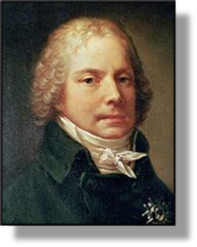
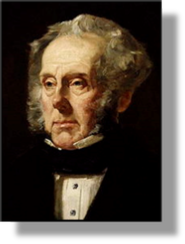 xxxxxToday, the Place des Martyres
in Brussels marks the burial site of 600 volunteers who died in the
fight for independence. They are rightly remembered for their
contribution to the forging of a new nation, but the
real architects were Lord Palmerston, the British Liberal foreign
minister (illustrated on right), and Charles Maurice Talleyrand, the French ambassador
to London at that time (illustrated on
left). A general war was averted because of
their determination to impose a peaceful settlement. Palmerston was
in favour of a neutral constitutional monarchy which, upheld by the
great powers, would ensure a friendly independent state - like
the Dutch Netherlands - facing England across the North Sea.
For their part, Talleyrand and his monarch, Louis-Philippe, had
no desire to reopen a quarrel with Britain. They sought a period of
peace for the development of France’s economy and the expansion of
its trade. Thus these two liberal powers, united in their aim -
albeit for different reasons - , stood their ground and won
their case against the reactionary powers of Russia, Prussia and
Austria (all three, be it noted, faced with possible rebellion at
home!). It was a political triumph for Talleyrand and also for
Palmerston, a statesman who, as we shall see, was to play an
important part in Britain’s foreign policy during the opening years
of Queen Victoria’s long reign (Va).
xxxxxToday, the Place des Martyres
in Brussels marks the burial site of 600 volunteers who died in the
fight for independence. They are rightly remembered for their
contribution to the forging of a new nation, but the
real architects were Lord Palmerston, the British Liberal foreign
minister (illustrated on right), and Charles Maurice Talleyrand, the French ambassador
to London at that time (illustrated on
left). A general war was averted because of
their determination to impose a peaceful settlement. Palmerston was
in favour of a neutral constitutional monarchy which, upheld by the
great powers, would ensure a friendly independent state - like
the Dutch Netherlands - facing England across the North Sea.
For their part, Talleyrand and his monarch, Louis-Philippe, had
no desire to reopen a quarrel with Britain. They sought a period of
peace for the development of France’s economy and the expansion of
its trade. Thus these two liberal powers, united in their aim -
albeit for different reasons - , stood their ground and won
their case against the reactionary powers of Russia, Prussia and
Austria (all three, be it noted, faced with possible rebellion at
home!). It was a political triumph for Talleyrand and also for
Palmerston, a statesman who, as we shall see, was to play an
important part in Britain’s foreign policy during the opening years
of Queen Victoria’s long reign (Va).
xxxxxIncidentally,
Leopold I, the
first king of Belgium, was related to the British royal family,
being the widower of Charlotte, daughter of George IV, and in 1832
he married Marie-Louise of Orleans, daughter of Louis-Philippe.
This made him acceptable to both Britain and France. In 1840 he
helped to arrange the marriage between his niece, Queen Victoria,
and his nephew Prince Albert of Saxe-Coburg-Gotha.
Including:
Poland, Germany
and the Papal
States

W4-1830-1837-W4-1830-1837-W4-1830-1837-W4-1830-1837-W4-1830-1837-W4-1830-1837-W4
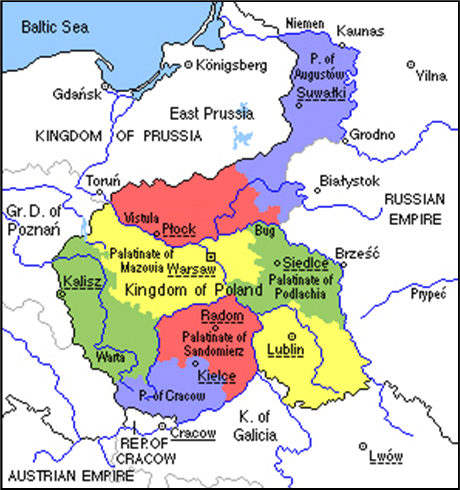 xxxxxBut if the Belgian revolutionaries were successful in
their quest for independence, the rebels in the Kingdom
of Poland (here illustrated),
were certainly not. Desperate to regain their national status, they
took heart from the rebellions in France and the Netherlands and
followed their example. In November 1830 the
capital city of Warsaw rose up in revolt, and within weeks the whole
country was up in arms - and this at the very time when the
autocratic Russian Tsar Nicolas I was planning to send a Polish army
against the French and Belgian rebels! The small number of Russian
troops stationed in Poland fled to their homeland, and the Poles
found themselves free under a government of their own making.
Independence was declared by the Polish diet and Tsar Nicholas was
promptly dethroned. But, as on earlier occasions, the movement for
freedom lacked the necessary unity. There was little or no co-ordination
or common aim between the landed nobility, the democratic elements
in Warsaw and the major cities, and the farm labourers who made up
the bulk of the nation. An army was formed, but the revolutionary
zeal of its soldiers could not compensate for their lack of training
and their lack of equipment. Inxthe spring
of 1831 the Russians launched their attack. The “rebels” were
overwhelmed at Ostrolenka
and within two days Russian forces were entering Warsaw in triumph.
xxxxxBut if the Belgian revolutionaries were successful in
their quest for independence, the rebels in the Kingdom
of Poland (here illustrated),
were certainly not. Desperate to regain their national status, they
took heart from the rebellions in France and the Netherlands and
followed their example. In November 1830 the
capital city of Warsaw rose up in revolt, and within weeks the whole
country was up in arms - and this at the very time when the
autocratic Russian Tsar Nicolas I was planning to send a Polish army
against the French and Belgian rebels! The small number of Russian
troops stationed in Poland fled to their homeland, and the Poles
found themselves free under a government of their own making.
Independence was declared by the Polish diet and Tsar Nicholas was
promptly dethroned. But, as on earlier occasions, the movement for
freedom lacked the necessary unity. There was little or no co-ordination
or common aim between the landed nobility, the democratic elements
in Warsaw and the major cities, and the farm labourers who made up
the bulk of the nation. An army was formed, but the revolutionary
zeal of its soldiers could not compensate for their lack of training
and their lack of equipment. Inxthe spring
of 1831 the Russians launched their attack. The “rebels” were
overwhelmed at Ostrolenka
and within two days Russian forces were entering Warsaw in triumph.
xxxxxThe Poles paid a heavy
price for their insubordination. Earlier, at the Vienna settlement
of 1815, Tsar Alexander I had converted the Duchy of Warsaw -
created by Napoleon - into a kingdom. He had remained its
monarch, but he had given this kingdom a constitution and allowed
the Polish Diet to have a voice in its own affairs, and some control
over its army. In 1831 Tsar Nicolas swept all this away, and Poland
was made a province within the Russian Empire. Furthermore, the
country was saddled with an army of occupation, Russian was made the
official language, and strict controls were imposed upon the press.
In addition, estates were confiscated, a number of educational
institutions were closed down, and many Poles were deported. But
bound and gagged though they were, the Poles clung tenaciously to
their hopes of nationhood. Revolutionary cells were set up across
the country and a number of rebellions were organised - notably
in 1846 and 1863 -, but it was not, in fact, until the First
World War of 1914 -1918 that independence was finally achieved.
Following the successive collapse of Russia, Austria and Germany,
the Second Polish Republic was proclaimed in November 1918, and in
1919 the Treaty
of Versailles put Poland back on the map of Europe.

 xxxxxIncidentally, one consequence
of the Russian crackdown was what came to be known as the Great
Emigration. About 6,000 leaders of the uprising were forced into
exile in the early 1830s, and these were accompanied or followed by
a large number of Polish artists and writers. The vast majority took
refuge in France, where Paris became the intellectual capital of the
Polish people. ……
xxxxxIncidentally, one consequence
of the Russian crackdown was what came to be known as the Great
Emigration. About 6,000 leaders of the uprising were forced into
exile in the early 1830s, and these were accompanied or followed by
a large number of Polish artists and writers. The vast majority took
refuge in France, where Paris became the intellectual capital of the
Polish people. ……
xxxxx…… And
the Polish rebellion of 1830 also forged a long-lasting
friendship between France and Poland. Both nations had taken up arms
in the cause of freedom, but, in addition, the French remained ever
conscious of the fact that, had the Poles not risen up when they
did, their country could have been faced with a formidable attack by
a reactionary Tsar bent on supporting reactionary monarchs.
The success of the popular rebellions in France
and the Netherlands inspired the Poles to seek their own independence.
In the Kingdom of Poland, created by Tsar
Alexander I out of Napoleon’s Duchy of Warsaw, they had gained a
certain amount of freedom to run their own affairs, but they wanted to
rid themselves of their Russian masters. Warsaw rose in revolt in
November 1830, and the rebellion quickly spread across the county. But
whilst there was much enthusiasm for the fight, the revolutionary army
was poorly equipped and trained, and there was a decided lack of
unity. In the spring of 1831 the Russians
launched an attack and, gaining a resounding victory at Ostrolenka,
swiftly crushed the uprising. In revenge, Tsar Nicolas turned the
Polish kingdom into a province of the Russian Empire, sent in an army
of occupation, made Russian the official language, and tightened press
censorship. But though bound and gagged, the Poles continued their
fight. Further rebellions were organised - notably in 1846 and
1863 - but it was not, in fact, until the Treaty of Versailles of
1919, following the First World War, that
Poland regained its place on the map of Europe.
xxxxxRebellion
in Germany following
the French revolution of July 1830 was limited and sporadic. For the
most part the 39 member states were held in a vice by the
reactionary governments of Austria and Prussia. In 1831 there were minor uprisings in the states of Hesse-Kassel,
Brunswick, Saxony and Hanover, and some acts of protest in the
Palatinate and at Frankfurt am Main, but they were swiftly put down.
In June 1832 the Austrian chancellor Metternich evoked the Carlsbad
Decrees of 1819, a set of articles designed to ensure the
maintenance of despotic government, and all dissent was silenced. It
was not until the middle of the century that another attempt was
made to confront the established order.
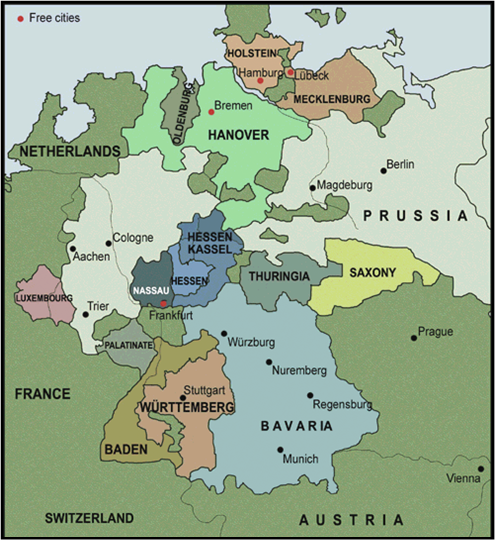 xxxxxOther
rebellions in Europe followed the Polish pattern, and were
likewise un-successful. During the post-Napoleonic
period in Germany,
the 39 member states were officially united by the governing
federal Bund, but in practice this body was simply used by the
Austrian chancellor Metternich to clamp down on liberalism and
nationalism. German democrats - and there were not many at
this time - were ruthlessly hunted down. Some of the larger
states in the south, such as Bavaria, Wurtemberg and Baden, had
gained a modicum of independence, but elsewhere there was strict
conformity to the dictates of the state. InxAustria
and Prussia, for example, the people were held in a reactionary
vice, though in Prussia the situation was to be somewhat mitigated
in 1834 by the Zollverein,
a German Customs Union which was destined to improve trade and
industry and give promise of a possible path to political
unification.
xxxxxOther
rebellions in Europe followed the Polish pattern, and were
likewise un-successful. During the post-Napoleonic
period in Germany,
the 39 member states were officially united by the governing
federal Bund, but in practice this body was simply used by the
Austrian chancellor Metternich to clamp down on liberalism and
nationalism. German democrats - and there were not many at
this time - were ruthlessly hunted down. Some of the larger
states in the south, such as Bavaria, Wurtemberg and Baden, had
gained a modicum of independence, but elsewhere there was strict
conformity to the dictates of the state. InxAustria
and Prussia, for example, the people were held in a reactionary
vice, though in Prussia the situation was to be somewhat mitigated
in 1834 by the Zollverein,
a German Customs Union which was destined to improve trade and
industry and give promise of a possible path to political
unification.
xxxxxIt was
against this background that rebellions broke out in a number of
states following the successful overthrow of the French autocratic
Charles X. During
1831 there were sporadic uprisings in
the states of Hesse-Kassel, Brunswick, Saxony and Hanover,
and a protest meeting of radicals in the Palatinate, whilst at
Frankfurt am Main a group of left-wing students attempted to
seize control of the city, dissolve the Diet, and proclaim a
German republic. The response of the authorities was predictable
and swift. The uprisings were brutally put down, and in June 1832
Metternich evoked the Carlsbad Decrees, a set of articles introduced in 1819 to ensure
despotic government was maintained in the federation. Promulgated
via the Bund, these and other repressive measures included an
increase in the powers of the police, stricter censorship, and
tighter controls on the right of assembly. All these steps were
highly successful. In Germany at this time there was no organised
political opinion. It was not until the middle of the century that
another attempt was made to confront the established order.
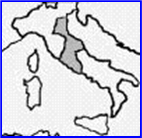 xxxxxNor, at this time, was any progress made towards
independence in Italy. There, rebellion was confined to the Papal States, and was very
quickly put down by the Austrians in March 1831,
called in by Pope Gregory XVI to restore the status quo. The
radical movement lacked co-ordination and leadership, and,
unlike the days of yore, no French army arrived on the scene to
give it support.
xxxxxNor, at this time, was any progress made towards
independence in Italy. There, rebellion was confined to the Papal States, and was very
quickly put down by the Austrians in March 1831,
called in by Pope Gregory XVI to restore the status quo. The
radical movement lacked co-ordination and leadership, and,
unlike the days of yore, no French army arrived on the scene to
give it support.
xxxxxBut whilst
the fall-out from the French revolution of July 1830 was
meagre - save for the independence achieved by Belgium -
it did play its part in chipping away at the old fashioned edifice
established by the Vienna settlement of 1815 and maintained by the
Congress system that followed in its wake. The forces of
liberalism and nationalism were not yet on the march in many parts
of Europe, but they were there to be counted and occasionally
felt. Their day was to come - in some countries at least.






 xxxxxThe first to seek independence was Belgium, the former
Austrian Netherlands. As we have seen, by the Congress of Vienna in
1815 (G3c), this
country, together with the United Provinces, was formed into the
Kingdom of the Netherlands and placed under the sovereignty of the
Dutch House of Orange. Established simply to provide a buffer state
against French expansion to the north, it was a union doomed to
failure. The two countries were separated by centuries of tradition,
spoke different languages, and were divided by religious faith and
racial make-
xxxxxThe first to seek independence was Belgium, the former
Austrian Netherlands. As we have seen, by the Congress of Vienna in
1815 (G3c), this
country, together with the United Provinces, was formed into the
Kingdom of the Netherlands and placed under the sovereignty of the
Dutch House of Orange. Established simply to provide a buffer state
against French expansion to the north, it was a union doomed to
failure. The two countries were separated by centuries of tradition,
spoke different languages, and were divided by religious faith and
racial make-
 xxxxxToday, the Place des Martyres
in Brussels marks the burial site of 600 volunteers who died in the
fight for independence. They are rightly remembered for their
contribution to the forging of a new nation, but the
real architects were Lord Palmerston, the British Liberal foreign
minister (illustrated on right), and Charles Maurice Talleyrand, the French ambassador
to London at that time (illustrated on
left). A general war was averted because of
their determination to impose a peaceful settlement. Palmerston was
in favour of a neutral constitutional monarchy which, upheld by the
great powers, would ensure a friendly independent state -
xxxxxToday, the Place des Martyres
in Brussels marks the burial site of 600 volunteers who died in the
fight for independence. They are rightly remembered for their
contribution to the forging of a new nation, but the
real architects were Lord Palmerston, the British Liberal foreign
minister (illustrated on right), and Charles Maurice Talleyrand, the French ambassador
to London at that time (illustrated on
left). A general war was averted because of
their determination to impose a peaceful settlement. Palmerston was
in favour of a neutral constitutional monarchy which, upheld by the
great powers, would ensure a friendly independent state -
 xxxxxBut if the Belgian revolutionaries were successful in
their quest for independence, the rebels in the Kingdom
of Poland (here illustrated),
were certainly not. Desperate to regain their national status, they
took heart from the rebellions in France and the Netherlands and
followed their example. In November 1830 the
capital city of Warsaw rose up in revolt, and within weeks the whole
country was up in arms -
xxxxxBut if the Belgian revolutionaries were successful in
their quest for independence, the rebels in the Kingdom
of Poland (here illustrated),
were certainly not. Desperate to regain their national status, they
took heart from the rebellions in France and the Netherlands and
followed their example. In November 1830 the
capital city of Warsaw rose up in revolt, and within weeks the whole
country was up in arms -
 xxxxxIncidentally, one consequence
of the Russian crackdown was what came to be known as the Great
Emigration. About 6,000 leaders of the uprising were forced into
exile in the early 1830s, and these were accompanied or followed by
a large number of Polish artists and writers. The vast majority took
refuge in France, where Paris became the intellectual capital of the
Polish people. ……
xxxxxIncidentally, one consequence
of the Russian crackdown was what came to be known as the Great
Emigration. About 6,000 leaders of the uprising were forced into
exile in the early 1830s, and these were accompanied or followed by
a large number of Polish artists and writers. The vast majority took
refuge in France, where Paris became the intellectual capital of the
Polish people. …… xxxxxOther
rebellions in Europe followed the Polish pattern, and were
likewise un-
xxxxxOther
rebellions in Europe followed the Polish pattern, and were
likewise un- xxxxxNor, at this time, was any progress made towards
independence in Italy. There, rebellion was confined to the Papal States, and was very
quickly put down by the Austrians in March 1831,
called in by Pope Gregory XVI to restore the status quo. The
radical movement lacked co-
xxxxxNor, at this time, was any progress made towards
independence in Italy. There, rebellion was confined to the Papal States, and was very
quickly put down by the Austrians in March 1831,
called in by Pope Gregory XVI to restore the status quo. The
radical movement lacked co-

